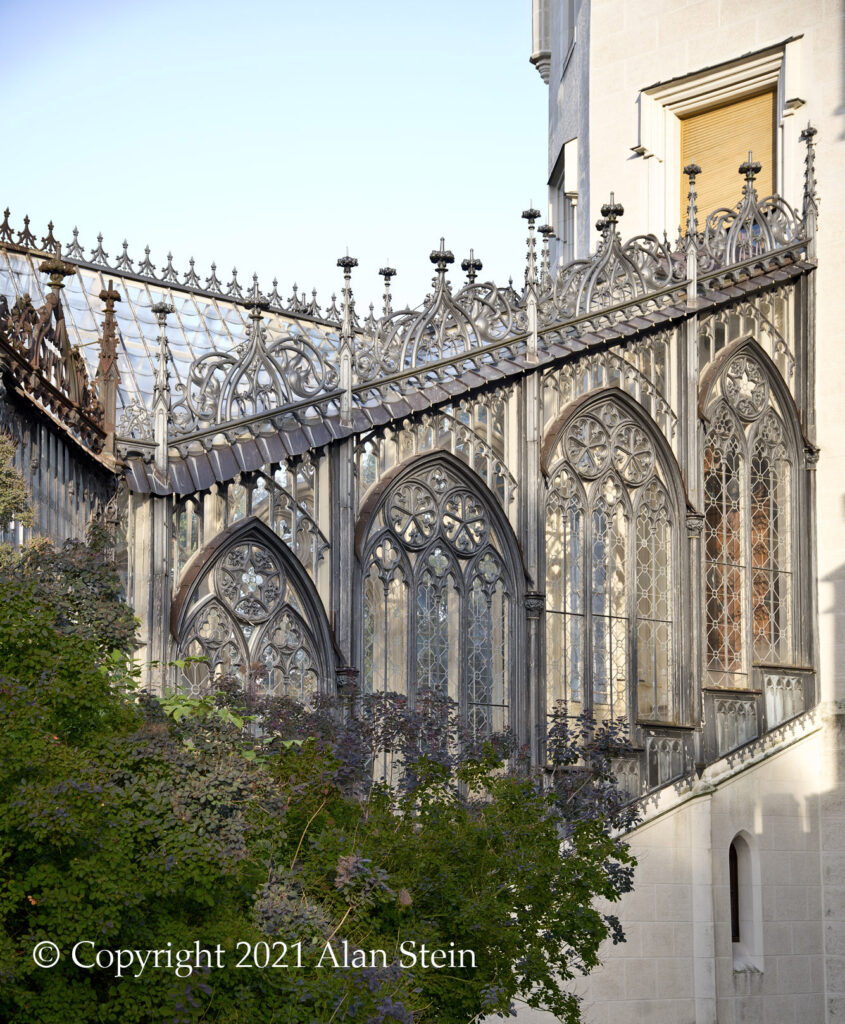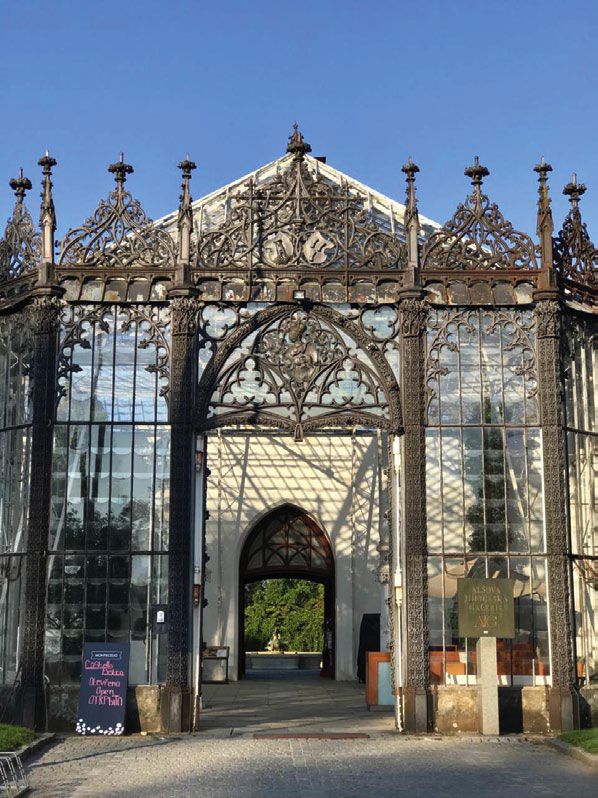How many ways can a glass conservatory be used?
Hluboká nad Vltavou is the large name of a tiny 100-year-old town with a population of about 5,000 in the Southern Bohemian area of the Czech Republic. The town’s castle, first built in the Gothic style in the 13th century, has been rebuilt numerous times. The latest version is the result of Johann Adolf II von Schwarzenberg ordering it reconstructed in the Romantic style of Windsor Castle in England in the 19th century. As part of that reconstruction, a charming glasshouse conservatory was added, bridging the castle with the riding school. As far as we know, this is a unique use for such a structure, but it does conjure some interesting ideas.
The construction of the glasshouse is a fine example of combining intricate cast iron with glass made possible by the beginning of the industrial revolution. The cast iron allowed lovely detailing on larger pieces; you’ll see pillars strewn with flowers and other decorations actually cast into the iron that supports the glass roof. Part of the reason for the conservatory was to create a warm space for the winter garden.

The detailing is amazing. Not just in the (very expensive in those times) detailing in the cast iron orten formed into small, decorative shapes, but in the unique stairway. Wrought iron makes up the stair which has then been covered by glass!
Care was taken to make the outside of this glasshouse visually match the castle; the inside looks whimsical but is strongly built to last while it protects the garden. There are more construction details here.
The castle, its glasshouse, and the surrounding gardens make an exciting destination. The castle is considered by many as one of the most beautiful in the Czech Republic and is a National Cultural Monument of the Czech Republic. “The contrast between the heavy masonry work and the filigree cast-iron ornamentation is a shape-forming architectural element.”
It can be fun, if you visit the Glasshouse at Hluboká, to see what features you might want to duplicate or what ideas they may spark for a conservatory of your own.
What we at Tanglewood so love about this glasshouse is the contrast between the outside and the inside coupled with the details – obviously they loved details as much as we do.
Small wonders live at the conservatory at chateau lednice
The Conservatory at Chateau Lednice at the Liechtenstein Castle in the southern area of Moravia in the Czech Republic is another example of the country’s superlative glass conservatories. When Duke Alois II, the Prince of Liechtenstein decided to add a conservatory during the remodel of his castle in 1840. He looked to England for the design, choosing English architect, P.H. Desvignes, to create the project which was built in the avant-garde Style of John Claudias Loudon. Desvignes began as an engineer who later studied at the Royal Academy of Arts.
Desvignes created the system of semi-circular arches ending in quarter spheres that give the conservatory a particularly graceful look as well as providing much of the building’s rigidity, eliminating the need for the diagonal supports so often seen in glass conservatories. The result is a sense of openness even as the glass protects the lednice_interior[1]contents from weather of all sorts. We’ve written about this type of construction here.
Famous for its many details, this conservatory leans on oriental designs. For example, Persian rugs inspired the design of the ventilation grilles while the capitals of the cast-iron pillars are based on banana leaves. Topped by a pagoda-like ventilation structure, the total effect is a bit like an exotic oriental garden.

Also known as the Lednice Orangery, this glass and cast iron structure was the first stand-alone glass house in Europe. Small wonder this lovely conservatory was designated a Conservatory Heritage Foundation site. A refurbishing of the structure revealed that in addition to cast-iron, forged iron was used in some of the decorative pillars.
The floor of the conservatory is another marvel. The path that leads one through the plantings is actually constructed of cast iron grates which allow heat from a heating system to warm the interior.
An ideal destination site for conservatory lovers traveling to the Czech Republic, the castle with its glass conservatory is set in the midst of an extensive landscape park or region of over 109 square miles. This huge park is designated as a ‘cultural landscape,’ an official term of World Heritage Sites which defines the area as “a landscape designed and created intentionally by man.” It stretches roughly between the Lednice and Valtice areas of the South Moravian Region, near Břeclav in the Czech Republic, providing much to explore for any visitor.
While you’re exploring, let your mind soar as you explore both the small and large details you dream about having in your own home! Your home can have the same atmosphere as the Chateau Lednice with designs and details that relate back to this century-old work of art!
Click the buttons below to see more historic conservatories or order a copy of our latest publication, The Conservatory: Gardens Under Glass where this conservatory and more are featured!

